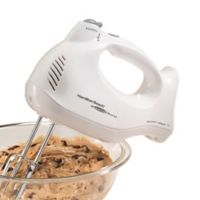Warning: These 10 Mistakes Will Destroy Your Mixer
Attachment issues followed a few these 7-quart mixers into kneading evaluations, too. Their dough hooks
Made limited or no contact whatsoever with all the ingredients once we added enough for a single batch of pizzaDough but capably mixed the ingredients when we added twice as much flour and water for dual
Batches (although both machines needed extra time to complete the bigger job).
However, the shape of the bowl along with the dough hook were secondary factors when it came to kneading.
To begin with, we had successes and failures with both C- and spiral-shaped hooks. More important,
Heavyweight tasks like kneading are more affected by the machinery itself than by the attachments.
back against the machine and increases the "load" on the motor. If a machine has enough power, it can
keep moving and mixing at its set speed despite that load; if it doesn't, the mixer will slow, which causes
the motor to heat up and potentially burn out.
But that
Wasn't the whole story: Several machines with relatively significant horsepower performed either
inconsistently or markedly worse than mixers with less than half as much oomph.
the machine's torque. Torque, or rotational force, provides leverage: The more torque a machine has
The more effectively it won't simply push on dough but also rotate it in the bowl. "Abundant torque
availability allows [the mixer's] speed to be held constant over a wide load range, while the beater of an
Underpowered mixer will lose speed as ingredients are added or dough stiffens, leading to inconsistent
mixing batch to batch," explained Michael Borgen, lead mechanical engineer at Metis Design
Corporation in Boston, Massachusetts. From the manufacturer's point of view, it's not always costeffective
To offer plenty of power, he added. "There is a balance to be struck. A motor with
superfluous power will unnecessarily increase the cost, size, and weight of a mixer." But an
underpowered mixer doesn't just deliver bad dough: When it slows or stalls, this strain makes the motor
more likely to burn out, explained Ruqiang Feng, professor of mechanical and materials engineering and
an American Society of Mechanical Engineers fellow at the University of Nebraska--Lincoln.
No mixer exemplified this more clearly than one particular machine, a front-runner until the kneading
tests. Not only did it shudder and lurch as it churned a single batch of dough but it became very hot (its
Best surface reached 100 degrees), emitted fumes, and from that test on rumbled angrily during both
light and heavy tasks. A second brand-new copy failed similarly, struggling to knead for several minutes
before finally shutting down. The bigger of the machines from another maker also struggled: Its dough
hook actually ripped off the shaft when it became overworked mixing super-stiff bagel dough, our most
demanding test. Suddenly, beefy-looking machines were boxing above their weight class--and a stand
Mixer that can't do anything more than a hand mixer is not worth the investment.
Made limited or no contact whatsoever with all the ingredients once we added enough for a single batch of pizzaDough but capably mixed the ingredients when we added twice as much flour and water for dual
Batches (although both machines needed extra time to complete the bigger job).
However, the shape of the bowl along with the dough hook were secondary factors when it came to kneading.
To begin with, we had successes and failures with both C- and spiral-shaped hooks. More important,
Heavyweight tasks like kneading are more affected by the machinery itself than by the attachments.
back against the machine and increases the "load" on the motor. If a machine has enough power, it can
keep moving and mixing at its set speed despite that load; if it doesn't, the mixer will slow, which causes
the motor to heat up and potentially burn out.
But that
Wasn't the whole story: Several machines with relatively significant horsepower performed either
inconsistently or markedly worse than mixers with less than half as much oomph.
the machine's torque. Torque, or rotational force, provides leverage: The more torque a machine has
The more effectively it won't simply push on dough but also rotate it in the bowl. "Abundant torque
availability allows [the mixer's] speed to be held constant over a wide load range, while the beater of an
Underpowered mixer will lose speed as ingredients are added or dough stiffens, leading to inconsistent
mixing batch to batch," explained Michael Borgen, lead mechanical engineer at Metis Design
Corporation in Boston, Massachusetts. From the manufacturer's point of view, it's not always costeffective
To offer plenty of power, he added. "There is a balance to be struck. A motor with
superfluous power will unnecessarily increase the cost, size, and weight of a mixer." But an
underpowered mixer doesn't just deliver bad dough: When it slows or stalls, this strain makes the motor
more likely to burn out, explained Ruqiang Feng, professor of mechanical and materials engineering and
an American Society of Mechanical Engineers fellow at the University of Nebraska--Lincoln.
No mixer exemplified this more clearly than one particular machine, a front-runner until the kneading
tests. Not only did it shudder and lurch as it churned a single batch of dough but it became very hot (its
Best surface reached 100 degrees), emitted fumes, and from that test on rumbled angrily during both
light and heavy tasks. A second brand-new copy failed similarly, struggling to knead for several minutes
before finally shutting down. The bigger of the machines from another maker also struggled: Its dough
hook actually ripped off the shaft when it became overworked mixing super-stiff bagel dough, our most
demanding test. Suddenly, beefy-looking machines were boxing above their weight class--and a stand
Mixer that can't do anything more than a hand mixer is not worth the investment.

Nhận xét
Đăng nhận xét